Mamikonian
Mamikonian or Mamikonean (Classical Armenian: Մամիկոնեան; reformed orthography: Մամիկոնյան; Western Armenian pronunciation: Mamigonian) was an aristocratic dynasty which dominated Armenian politics between the 4th and 8th century. They ruled the Armenian regions of Tayk, Taron, Sasun, Bagrevand and others. Their patron saint was Saint Hovhannes Karapet (John the Baptist) whose monastery of the same name (also known as Glak) they fiercely defended against the Sassanid invaders.[1]
| Mamikonian | |
|---|---|
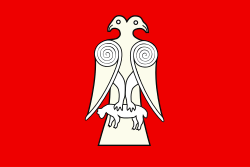 | |
| Country | Armenia Persia |
| Founded | 314 |
| Founder | Artavasdes I |
| Current head | Extinct |
| Final ruler | Musel VI |
| Titles |
|
| Dissolution | 1189 |
| Cadet branches | Liparitids Tumanishvili |
Origin
The origin of the Mamikonians is shrouded in the mists of antiquity. Moses of Chorene in his History of Armenia (5th century) claims that three centuries earlier two noblemen of "Chem" (Arm. "Ճեմ"; plur. "Ճեմք") origin (which is speculated to mean probably Chinese origin), Mamik and Konak, rose against their half-brother, Chenbakir, the king of Chenk (which possibly refers to China). They were defeated and fled to the king of Parthia who, braving the Emperor's demands to extradite the culprits, sent them to live in Armenia, where Mamik became the progenitor of the Mamikonians.
Another 5th-century Armenian historian, Pavstos Buzand, seconded the story. In his History of Armenia, he twice mentions that the Mamikonians descended from the Han Dynasty of China and as such were not inferior to the Arshakid rulers of Armenia. This genealogical legend may have been part of an agenda by the Bagratid dynasty of Armenia to take away the legitimacy off the Mamikonian dynasty. Although it echoes the Bagratids' claim of Davidic descent and the Artsruni's claim of the royal Assyrian ancestry, some Armenian historians tended to interpret it as something more than a piece of genealogical mythology.[2] A theory from the 1920s postulated that the Chenk mentioned in the Armenian sources were not Han-Chinese but probably from a different Iranian-speaking ethnic group from Transoxania, such as the Tocharians in Northwest China.[3] Edward Gibbon in his The History of the Decline and Fall of the Roman Empire also believed that the founder of Mamikonian clan was not Han-Chinese but merely from the territory of the Chinese Empire and ascribes a Scythian origin to Mamgon stating that at the time the borders of the Chinese Empire reached as far west as Sogdiana.[4]
Another reconstruction, similar to the previous ones but without references whatsoever to distant China, has that the family originally immigrated from Bactriana (present northern Afghanistan) under the reign of Tiridates II of Armenia,[5] likely coinciding with the accession of the Sassanids in Iran.
More recent theories, however, suggests that the "Chank" are to be identified either with the Tzans, a tribe in the southern Caucasus, or with a Central Asian group living near the Syr Darya river.[6]
In the words of Nina Garsoïan / Encyclopædia Iranica:[7]
The Mamikoneans claimed to be of royal Čenkʿ descent, a people traditionally associated with China (Primary History, B; BP-G, 5.4.37, pp. 194, 218-19; MK, 2.81, pp. 229-31). Although this origin is disputed by scholars, who have not yet reached a final conclusion, the Mamikoneans have been thought to have come from Central Asia or from the region of Darband. Adontz and especially Toumanoff considered that their ancestry should be linked with Georgia (Adontz, 1970, p. 312; Toumanoff, 1963, pp. 209-10).
Early history
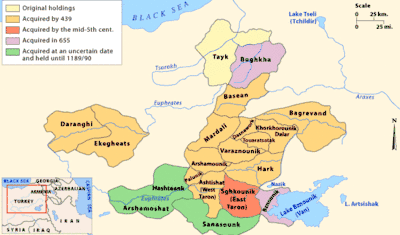
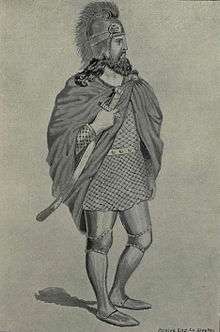
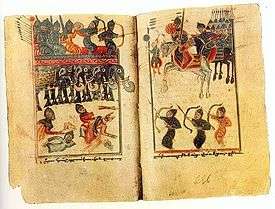
The family first appears in the early 4th century. Under the late Arsacid Kingdom of Armenia, the family occupied an important position: they were hereditary commanders-in-chief (sparapet) and royal tutors (dayeak) and controlled large domains, including most of Taron and Tayk. The Mamikonian increased their property further with the death of the last hereditary Patriarch of Armenia, Isaac in ca. 428, when they inherited many Church lands through the marriage of his only daughter to Hamazasp Mamikonian.[6]
The first known Mamikonid lord, or nakharar, about whom anything certain is known was a certain Vatche Mamikonian (fl. 330-339).
The family reappears in chronicles in 355, when the bulk of their lands lay in the province of Tayk. At that point the family chief was Vassak Mamikonian, who was the sparapetof Armenia. Later, the office of sparapet would become hereditary possession of the Mamikonians. Vassak Mamikonian was in charge of the Armenian defense against Persia but was eventually defeated through the treachery of Merujan Artsruni (c. 367-368).
Following the defeat, Vassak's brother Vahan Mamikonian and multiple other feudal lords defected to the Persian side. The Emperor Valens, however, interfered in Armenian affairs and had the office of sparapet bestowed on Vassak's son Mushegh I Mamikonian in 370. Four years later Varasdates (Varazdat), a new king, confirmed Mushegh in office. The latter was subsequently assassinated on behest of Sembat Saharuni who replaced him as sparapet' of Armenia.
On this event, the family leadership passed to Mushegh's brother, Manuel Mamikonian, who had been formerly kept as a hostage in Persia. The Mamikonids at once broke into insurrection and routed Varasdates and Saharuni at Karin. Emmanuel, together with his sons Hemaiak and Artches, took the king prisoner and put him in a fortress, whence Varasdates escaped abroad. Zarmandukht, the widow of Varasdates' predecessor, was then proclaimed queen. Emmanuel came to an agreement with the powerful Sassanids, pledging his loyalty in recompense for their respect of the Armenian autonomy and laws.
Upon the queen's demise in 384, Manuel Mamikonian was proclaimed Regent of Armenia pending the minority of her son Arsaces III and had the infant king married to his daughter Vardandukht. It was Manuel's death in 385 that precipitated the country's conquest by the Persians in 386-387.
Hamazasp Mamikonian was recorded as the family leader in 393. His wife is known to have been Sahakanoush, daughter of Patriarch Isaac the Great. She was a descendant of the Arsacid Kings and Saint Gregory the Illuminator. They had a son, Vardan Mamikonian, who is revered as one of the greatest military and spiritual leaders of ancient Armenia.
After Vardan became sparapet in 432, the Persians summoned him to Ctesiphon. Upon his return home in 450, Vardan repudiated the Persian (Zoroastrian) religion and instigated a great Armenian rebellion against their Sassanian overlords. Although he died in the doomed Battle of Avarayr also known as Battle of Vartanantz (451), the continued insurrection led by Vahan Mamikonian, the son of Vartan's brother, resulted in the restoration of Armenian autonomy with the Nvarsak Treaty (484), thus guaranteeing the survival of Armenian statehood in later centuries. Vardan is venerated as a saint and commemorated by many churches in Armenia and an equestrian statue in Yerevan.
After the country's subjugation by the Persians, the Mamikonians often sided with the Eastern Roman Empire, with many family members entering Byzantine service, most notably Vardan II Mamikonian in the late 6th century after his failed revolt against Persia.[6]
With the Arab conquest of Armenia in the late 7th century, the power of the Mamikonian began to decline, especially relative to their great rivals, the Bagratids. Grigor Mamikonian led a rebellion against Arab rule but was defeated and forced to flee to Byzantium in ca. 748.[6] By 750, the Mamikonians had lost Taron, Khelat, and Mouch to the Bagratids. In the 770s, the family was led by Artavizd Mamikonian, then by Mushegh IV Mamikonian (+772) and by Samuel II. The latter married his daughter to Smbat VII Bagratuni, constable of Armenia. His grandson Ashot Msaker ("the Carnivorous") became forefather of Bagratid rulers of Armenia and Taron.
The final death-blow to the family's power came in the mid-770s, with the defeat and death of Mushegh VI Mamikonian at the Battle of Bagrevand against the Abbasids. In its aftermath, Mushegh's two sons took refuge in Vaspurakan and were murdered by Merouzhan II Artsruni, and his daughter was married off to Djahap al-Qais, a tribal chief who settled in Armenia and seized part of the former Mamikonian lands and legalized it by marrying the daughter of Mushegh VI, the last living Mamikonian prince. This marriage created the Kaysite Dynasty of Arminiya centered in Manzikert, the most powerful Muslim Arab emirate in the Armenian Highlands region, and thus ending the existence of the Mamikonian line in Armenia. Only secondary lines of the family survived thereafter, both in Transcaucasia and in Byzantium.[6] Even in their homeland of Tayk, they were succeeded by the Bagratids. One Kurdik Mamikonian was recorded as ruling Sasun c. 800, where the Surb Karapet Monastery and family seat was. Half a century later, Grigor Mamikonian lost Bagrevand to the Muslims, reconquered it in the early 860s and then lost it to the Bagratids, permanently. After that, the Mamikonians pass out of history.
After their disastrous uprising of 774–775, some of the Mamikonian princes moved to the Georgian lands. The latter-day Georgian feudal houses of the Liparitids-Orbeliani and Tumanishvili are sometimes surmised to have been descended from those princes.[9]
Several scholars—most notably Cyril Toumanoff and Nicholas Adontz—have suggested a Mamikonian origin for a number of leading Byzantine families and individuals, beginning with the usurper Phocas in the early 7th century, emperor Philippikos Bardanes, the general and usurper Artabasdos in the mid-8th century, and the families of men like Alexios Mosele or Empress Theodora and her brothers Bardas and Petronas in the 9th century. However, as the Armenian historian N. Garsoïan comments, "[a]ttractive though it is, this thesis cannot be proven for want of sources".[6]
Genealogy
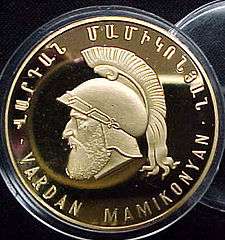
The history of Mamikonians in the Early Middle Ages is quite obscure. In the period between 655 and 750 they are not documented at all. What follows below is their reconstructed genealogy between the 5th and 7th centuries.
- Hamazasp I Mamikonian, married to Sahankanoysh of Armenia
- 1. Vardan I (+451) (saint)
- 1.1. Shushanik (+October 17, 475, Tsurtavi, Georgia) (saint)
- 2. Hmayeak I (+June 02, 451, in Tao, Tao-Klarjeti region, Georgia)
- 2.1. Vahan
- 2.1.1. Vard
- 2.2. Vasak
- 2.2.1. Manuel
- 2.2.1.1. Gaghik
- 2.2.2. Vardan II
- 2.2.2.3. Mamak (fl. 590)
- 2.2.3 daughter
- 2.2.3.1. Mushegh II (+c. 593)
- 2.2.3.1.1. Kahan Gail (fl. 592-604)
- 2.2.3.1.1.1. Smbat the Valiant (fl. 604)
- 2.2.3.1.1.1.1. Mushegh III (+636)
- 2.2.3.1.1.1.1.1. Grigor I (fl. 650)
- 2.2.3.1.1.1.1.2. Hamazasp II (fl. 655)
- 2.3. Artaches
- 2.4. Vard
- 3. Hamazaspian
Necropolis
The necropolis of the Mamikonian family was at the 4th century Saint Karapet Monastery (also known as the monastery of Glak) in the mountains directly northwest of the plain of Mush in Taron.
See also
- Saint Vartan
- Saint Shushanik
- Battle of Avarayr
- Union of the Armenian Noblemen
- Sophie Audouin-Mamikonian, French pretender to the throne of the Ancient Kingdom of Armenia.
References
- Mamikonean, John (1985), "Translator's Preface", in Robert Bedrosian (ed.), History of Taron, New York "Archived copy". Archived from the original on December 15, 2005. Retrieved 2005-12-15.CS1 maint: archived copy as title (link) CS1 maint: BOT: original-url status unknown (link)
- H. Skold, "L'Origine des Mamiconiens", Revue des etudes armeniennes (1925) pp. 134-35.
- Edward Gibbon, The History of the Decline and Fall of the Roman Empire:Chapter XIII, Part II, Reign of Diocletian and This Three Associates.
- Vahan M. Kurkjian, A History of Armenia, Armenian General Benevolent Union of America 1958: Chapter XVII The Arsacids (Arshakunis) of Armenia
- Garsoïan, Nika (1991). "Mamikonean". In Kazhdan, Alexander (ed.). The Oxford Dictionary of Byzantium. Oxford University Press. pp. 1278–1279. ISBN 978-0-19-504652-6.
- Garsoian 2005.
- Vartan Mamikonian illustration in 1898 book «Illustrated Armenia and Armenians»
- Toumanoff, Cyril. "The Mamikonids and the Liparitids", Armeniaca (Venice, 1969), pp. 125-137.
Sources
- Garsoian, Nina (2005). "MAMIKONEAN FAMILY". Encyclopaedia Iranica.CS1 maint: ref=harv (link)
Further reading
- Mamikonean, John (1985), Robert Bedrosian (ed.), History of Taron, New York
